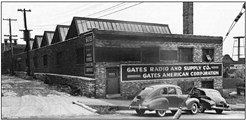Gates Air renews old name, tradition in Quincy

Last March, the Harris Broadcast Corp. changed its name to GatesAir.
In the process, the Gores Group, which now owns Quincy’s legacy broadcast equipment manufacturer, tipped its hat to the 90-year history of the company that was known for decades as the Gates Radio Co. This local manufacturer turned Quincy into a radio and television technology magnet, eventually drawing other companies to the area, including Broadcast Electronics and Glenayre.
To this day, more broadcast transmitters are made in Quincy than any other city in the world.
It started in the fall of 1921 in the Quincy home of Henry and Cora Gates. According to Janet Gates Conover, that was when their 14-year-old son, Parker, took an after-school job in the radio department of the Kresge Co. He used his modest salary to buy radio parts and built a few radio sets. At a Quincy Rotary meeting, his father said, “My son can build a radio that is better than any you can buy in a store,” and walked out with orders for five of Parker’s $200 radios.
So in early 1922, to create a part-time job for their son, Henry and Cora founded the Gates Radio & Supply Company in the kitchen pantry of their apartment. It would be the only job Parker would ever hold.
The business grew, and in 1924 Henry quit his job and went into business full time with his son. They leased office space at 115½ N. Fifth, where Henry managed the business, Cora was bookkeeper and Parker designed, built and repaired radio equipment.
Their first major product was a sound system used in early “talkie” movie theaters. The Gates Co. also developed and sold broadcast remote amplifiers, transcription turntables and condenser microphones. There were two “field sound trucks” that provided public address facilities at local events.
One of Parker’s school friends was Elmer Wavering, another radio enthusiast who worked at the Quincy Radio Laboratory on Seventh and Hampshire. The young men thought it would be a challenge to install a radio in their car to impress the girls.
They quickly ran into the problem of interference from the car’s ignition system, which had been an obstacle to radio reception in vehicles until then.
Elmer took the problem to his boss, Bill Lear of Hannibal, who collaborated with the young men to solve their problems. Before long, they had built one of the world’s first practical car radios.
Lear later went to Chicago and partnered with electronics manufacturer Paul Galvin to develop and market car radios under the name “Motorola.” They invited Wavering to join the company, and Elmer eventually became its president and CEO.
Lear went on to become a world-renowned inventor, creating the first aircraft radio compass, the automatic pilot, the eight-track tape player and the Learjet.
Meanwhile, Parker Gates stayed in Quincy and slowly developed his small electronics company into a major industry force.
As its business grew in the 1930s, the Gates Radio & Supply Co. moved several times to larger factory space, ending at 220 Hampshire.
In mid-decade, Gates built one of the radio industry’s first audio consoles and introduced its first AM radio transmitter. During World War II, Gates received several subcontracts for military shortwave transmitters.
In 1944, Parker Gates was one of the few civilians who was told in advance about D-Day when Gates was contracted to provide transmitters for the invasion.
The factory ran around the clock for nearly 30 days building transmitters for the battle. Cots were set up in the factory so the employees could take naps and then return to work.
In 1945, Gates moved into a group of buildings at 124 Hampshire, and then in 1953 an even larger plant was built at 30th and Broadway. Both facilities operated until Gates consolidated all operations at the present Wismann Lane location in 1977. By then, the Gates Radio Co. had become one of the country’s two dominant radio and television equipment suppliers — a major provider of audio consoles, turntables, AM, FM and shortwave radio transmitters and accessories.
One of the company’s biggest projects was to supply the studio equipment for the Voice of America headquarters in Washington. The contract was awarded in May 1954. It included a custom-built 22-foot-long audio console that could switch any one of 100 audio sources to 25 outputs. There were also dozens of studio consoles and 65 cabinets of supporting equipment.
In 1957, the company was acquired by the Harris Intertype Corp. Parker remained as president of the division for another 10 years, during which time the company gradually became known as Harris Broadcast Communications.
In succeeding decades, Harris was a leader in broadcast technology with innovative FM and TV transmitters, including multi-megawatt AM systems, new AM technologies and some of the industry’s first solid state AM, FM and TV transmitters.
A full line of television products was created through in-house development and corporate acquisitions.
Harris moved its management offices to Ohio, in 1998, and then to Colorado in 2010, but the manufacturing facility has stayed in Quincy.
In recent years, Harris engineers made important contributions to the development of high-definition television and HD radio technology.
In 1992, the Harris Broadcast Division celebrated its 70th anniversary by naming a Quincy street as “Parker Gates Avenue.”
This past March, the company was split into two divisions, renamed Gates Air and Imagine Communications. There are now about 200 employees at the Quincy facility on Wismann Lane. Parker S. Gates died at age 79 on Sept. 16, 1986, and his wife, Millie, died in May 2013. Their three daughters still live in Quincy.
John Schneider moved to Quincy in 1998 when he joined Broadcast Electronics. He now works for iBiquity Digital Corp. in Columbia, Md., but continues to live in Quincy. He has written two books and numerous magazine articles on radio history.






